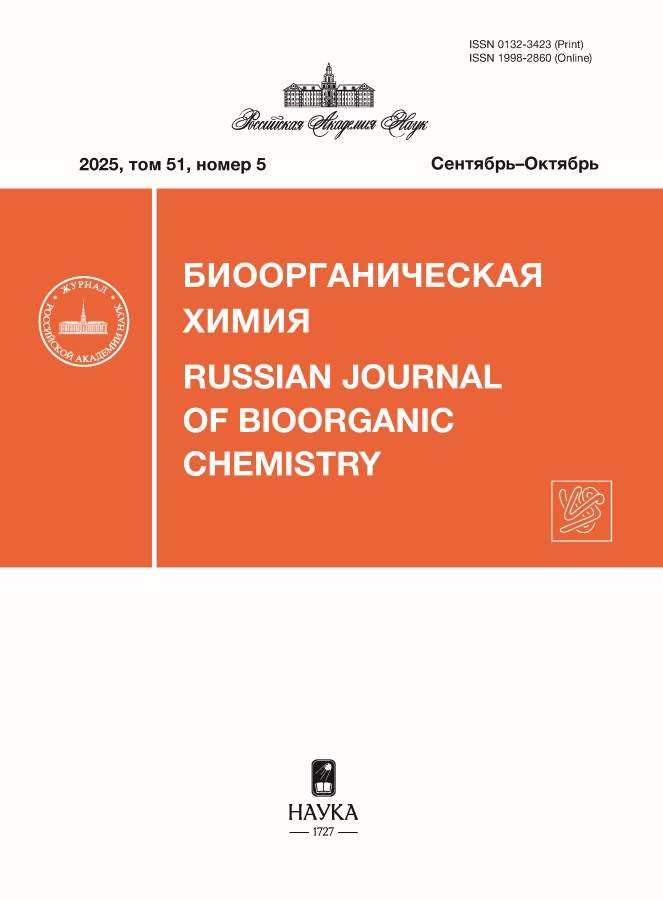Study of the Antiproliferative Activity of a Humanized Antibody to the Cancer-Testis Antigen PRAME
- Authors: Larina M.V1, Finashutina Y.P2, Kravchuk N.A2, Misyurin V.A2, Novoseletsky V.N3, Balabashin D.S1, Solopova O.N2, Sokolova D.V2, Pokrovsky V.S2, Dolgikh D.A1,4, Aliev T.K1,5, Misyurin A.V6, Kirpichnikov M.P1,3
-
Affiliations:
- Shemyakin–Ovchinnikov Institute of Bioorganic Chemistry, Russian Academy of Sciences
- N. N. Blokhin National Medical Research Center of Oncology
- Biology Department, Shenzhen MSU-BIT University
- Faculty of Biology, Lomonosov Moscow State University
- Faculty of Chemistry, Lomonosov Moscow State University
- Yavilov Institute of General Genetics, Russian Academy of Sciences
- Issue: Vol 51, No 5 (2025)
- Pages: 920-930
- Section: ЭКСПЕРИМЕНТАЛЬНЫЕ СТАТЬИ
- URL: https://ruspoj.com/0132-3423/article/view/695720
- DOI: https://doi.org/10.31857/S0132342325050174
- ID: 695720
Cite item
Abstract
Keywords
About the authors
M. V Larina
Shemyakin–Ovchinnikov Institute of Bioorganic Chemistry, Russian Academy of Sciences
Email: marya.larina@gmail.com
Moscow, Russia
Yu. P Finashutina
N. N. Blokhin National Medical Research Center of OncologyMoscow, Russia
N. A Kravchuk
N. N. Blokhin National Medical Research Center of OncologyMoscow, Russia
V. A Misyurin
N. N. Blokhin National Medical Research Center of OncologyMoscow, Russia
V. N Novoseletsky
Biology Department, Shenzhen MSU-BIT UniversityShenzhen, China
D. S Balabashin
Shemyakin–Ovchinnikov Institute of Bioorganic Chemistry, Russian Academy of SciencesMoscow, Russia
O. N Solopova
N. N. Blokhin National Medical Research Center of OncologyMoscow, Russia
D. V Sokolova
N. N. Blokhin National Medical Research Center of OncologyMoscow, Russia
V. S Pokrovsky
N. N. Blokhin National Medical Research Center of OncologyMoscow, Russia
D. A Dolgikh
Shemyakin–Ovchinnikov Institute of Bioorganic Chemistry, Russian Academy of Sciences; Faculty of Biology, Lomonosov Moscow State UniversityMoscow, Russia; Moscow, Russia
T. K Aliev
Shemyakin–Ovchinnikov Institute of Bioorganic Chemistry, Russian Academy of Sciences; Faculty of Chemistry, Lomonosov Moscow State UniversityMoscow, Russia; Moscow, Russia
A. V Misyurin
Yavilov Institute of General Genetics, Russian Academy of SciencesMoscow, Russia
M. P Kirpichnikov
Shemyakin–Ovchinnikov Institute of Bioorganic Chemistry, Russian Academy of Sciences; Biology Department, Shenzhen MSU-BIT UniversityMoscow, Russia; Shenzhen, China
References
- Ikeda H., Lethe B., Lehmann F., van Baren N., Baurain J.F., de Smet C., Chambost H., Vitale M., Moretta A., Boon T., Coulie P.G. // Immunity. 1997. V. 6. P. 199–208. https://doi.org/10.1016/s1074-7613(00)80426-4
- Kessler J.H., Beekman N.J., Bres-Vloemans S.A., Verdijk P., van Veelen P.A., Kloosterman-Joosten A.M., Vissers D.C., ten Bosch G.J., Kester M.G., Sijts A., Wouter Drijfhout J., Ossendorp F., Offringa R., Melief C.J. // J. Exp Med. 2001. V. 193. P. 73–88. https://doi.org/10.1084/jem.193.1.73
- Greiner J., Schmitt M., Li L., Giannopoulos K., Bosch K., Schmitt A., Dohner K., Schlenk R.F., Pollack J.R., Dohner H., Bullinger L. // Blood. 2006. V. 108. P. 4109–4117. https://doi.org/10.1182/blood-2006-01-023127
- Weber G., Caruana I., Rouce R.H., Barrett A.J., Gerdemann U., Leen A.M., Rabin K.R., Bollard C.M. // Clin. Cancer Res. 2013. V. 19. P. 5079–5091. https://doi.org/10.1158/1078-0432.ccr-13-0955
- Schneider V., Zhang L., Rojewski M., Fekete N., Schrezenmeier H., Erle A., Bullinger L., Hofmann S., Gotz M., Dohner K., Ihme S., Dohner H., Buske C., Feuring-Buske M., Greiner J. // Int. J. Cancer. 2015. V. 137. P. 2083–2092. https://doi.org/10.1002/ijc.29583
- Babiak A., Steinhauser M., Gotz M., Herbst C., Dohner H., Greiner J. // Oncol. Rep. 2014. V. 31. P. 384– 390. https://doi.org/10.3892/or.2013.2804
- Greiner J., Ringhoffer M., Simikopinko O., Szmaragowska A., Huebsch S., Maurer U., Bergmann L., Schmitt M. // Exp. Hematol. 2000. V. 28. P. 1413–1422. https://doi.org/10.1016/s0301-472x(00)00550-6
- Hermes N., Kewitz S., Staege M.S. // Curr. Cancer Drug Target. 2016. V. 16. P. 400–414. https://doi.org/10.2174/1568009616666151222151818
- Larina M.V., Finashutina Y.P., Lyzhko N.A., Misyurin V.A., Novoseletsky V.N., Dolgikh D.A., Solopova O.N., Moysenovich A.M., Balabashin D.S., Aliev T.K., Misyurin A.V., Kirpichnikov M.P. // Russ. J. Bioorg. Chem. 2022. V. 48. P. 360–371. https://doi.org/10.1134/S1068162022020133
Supplementary files











